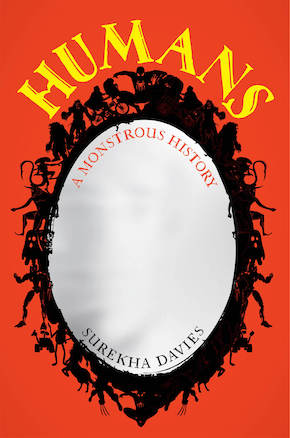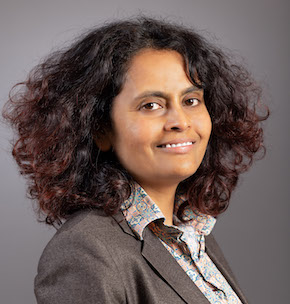Moving on from making monsters
by Surekha Davies
MONSTER-MAKING IS CONTAGIOUS. Centuries-old narratives about who does or doesn’t belong in a community or a nation and about who is monstrous because they threaten the imagined unity and distinctiveness of the whole have a habit of inspiring new monstrifying narratives. The Nazis explicitly studied, adapted, and expanded to a terrifying degree European formulations of racial hierarchy and colonial European and American justifications for expanding their geographic frontiers, segregationist policies, and the practice of eugenics – all at the expense of Jewish, LGBTQIA+, disabled, Roma, Sinti, Black, Indigenous, and Brown people.
Even the targets of monster-making – the victims of harrowing abuse, discrimination, and genocide – can become monster-makers, spinners of new narratives that monstrify people who are more vulnerable. Nowhere has this been more apparent, more horrific, and more volatile than the Israel-Hamas War, which began in October 2023. The language of monster-making has been everywhere.
Within days of Hamas’s breach of the Gaza-Israel border and the attack by some 1,500 militants on Israeli communities, Israeli ministers were calling Palestinians “human animals.” Months into the conflict, the Israeli government’s justification of civilian deaths expanded from destroying Hamas’s underground tunnels to the claims that there are no Palestinian civilians, that every Palestinian aged four and up is a terrorist or potential terrorist; and that Palestinians do not exist as a people but are merely wanderers, Arabs from elsewhere.
Trying to make sense of the present war is to experience vertigo. Time contracts to a single day of horror, in which some 1,400 people, most of them Israelis, were murdered, more than 200 were taken hostage, hundreds were wounded and physically assaulted in unspeakable ways, and millions were traumatized, in and around Israel. In the next moment, time and space expand, as if October 7 were a star going supernova and ejecting psychic memory matter, old ghosts, into the universe in pulsing waves, into the past and the future.
More than fifty thousand Palestinians have died, and more are dying, and not just at the hands of Israeli soldiers firing US-funded weapons. They are also dying because of the monstrification that Europe and especially Nazi Germany enacted on Jewish people in living memory. But that cycle too goes back in time. One of the ways that both Nazis and Stalinists built support for their murderous causes was by declaring that the woes of workers were the fault not of capitalism or feudalism but of rich Jews. The twentieth-century Jewish exodus to what became the state of Israel is in part the aftershock of those atrocities. This type of strategy – of monstrifying minority groups and blaming them for a nation’s ills – is still the Far Right’s election playbook, currently unfolding everywhere from Brazil to India, from the United Kingdom to China, from France to the United States. Black and Brown people; Indigenous people dispossessed by settler-colonialism; ethnic and religious minorities; and LGBTQIA+ communities are their regular targets. Acts against vulnerable populations can be both horrific and distinct from one another. That doesn’t negate the wrongs done to any particular group. “Oppression Olympics” will fix nothing. Instead, it gives the billionaire class and the Far Right a wedge with which to pry apart solidarities across race, gender, religion, sexual orientation, education level, industry, and (even) politics. Instead of monstrifying other groups who are also poor, marginalized, or vulnerable, we might instead acknowledge everyone’s humanity.
There are no monsters: there are only stories that monstrify people, systems that fail people, and assumptions that dehumanize people. It’s time for new stories, better systems.”
Naming and classification are monster-making acts. A library’s worth of such acts sits in the foundations of the contemporary world, ready to be pulled out and used for thinking with at a moment’s notice. Nations legislate against their chosen, invented monsters and thereby define the boundaries of their own identities. Nation and race are both local and global biopolitical lenses on human variety, bringing into being categories and category-disrupting communities. From the myth of Manifest Destiny to the myth of Greater Russia, stories told about geography, race, and nation justify land grabs and genocide. By looking across time at how people have monstrified communities at their nation’s geographic boundaries and have monstrified groups whom they frame as their opposite, we can see how these ideas operate and intersect and then work to diminish their power. There are no monsters: there are only stories that monstrify people, systems that fail people, and assumptions that dehumanize people. It’s time for new stories, better systems, and evidence and ethics in place of monstrifying assumptions.
I write this at a moment not just of geopolitical disaster but of climate and ecological catastrophe. From rising sea levels to cancer-causing chemicals in cookies, the consequences of acting as if humans and ecology are separate have a knock-on effect on humanity itself. The nature/culture divide of the modern West has become increasingly untenable as the planet speaks back to humanity through extreme weather events. Numerous species have seen their numbers tumble from pesticide exposure. Human beings are also changing in response to artificial chemicals, making humans subtly but fundamentally different over time, changes that will shape future generations. Human sperm counts have been dropping. Sometimes deep change is hidden for years, even decades: radiation works on life at the cellular level, only manifesting its handiwork when it is too late to undo it. Are we turning ourselves from one sort of species into another, passing through some in-between, monstrous phase?
Climate justice would involve, among other things, polluters paying for their impact on their environment. Companies and individuals made multi-billion-dollar profits by burning fossil fuels for manufacturing, creating pesticide waste, underpaying workers who mine rare materials in dangerous conditions, and shipping their products (more fuel emissions and perhaps oceanic pollution) – the list goes on. People wonder what major pathogen will emerge next from ecosystems under pressure from humans, be it yet another SARS coronavirus or an anthrax epidemic caused by decades-old infected reindeer carcasses revealed by the melting of permafrost. If ecologically vital species like bees disappear, it could trigger a cascade reaction of extinction. How societies imagine the relationship between natural and human spheres of activity will shape environmental legislation and disaster management in the decades to come.
Today many of us live and work in places where laws and infrastructure bind us into an unsustainable relationship with ecology. Structures and practices that accelerated during the Industrial Revolution, notably the burning of fossil fuels, serve some people in the short term but harm people and damage ecologies around the world in the medium and long term. Attending to the blurry, connected space between humans and ecology highlights why it is worth seeking non-polluting, environmentally sustainable approaches to life on earth – rather than remaining dependent on our fossil fuel-consuming, pollution-generating hacks. By ceasing to draw a sharp line between where human supposedly ends and ecology begins, societies would be better able to make environmental decisions that preserve or improve people’s lives while also safeguarding the environment for future lives in all forms. Our minds, bodies, and futures don’t end at our skin.
Someone looking at the world through the lens of Indigenous cosmologies would likely understand beings as interconnected and interdependent. Alien exobiologists studying human societies in their ecologies might agree.
But modern Western thought has alienated humanity from the earth and some billionaires fund plans to leave the planet rather than to save it. Instead, why don’t we lean into what we are: imperfect, mortal humans who are infinitely creative and capable of communicating and working together, even when it is hard. And we could lean into where we are: the only habitable and inhabited world we know of, full of so many forms of life that we haven’t even named them all. Surely that’s worth working to preserve rather than to escape or to abandon.
Monsters are portals.
Monsters are us.
Let’s get to work.
Excerpted from Humans: A Monstrous History, courtesy of the University of California Press © 2025
—

Surekha Davies is a British author, speaker and historian of science, art and ideas. Her first book, Renaissance Ethnography and the Invention of the Human, won the Morris D. Forkosch Prize for the best first book in intellectual history from the Journal of the History of Ideas, and the Roland H. Bainton Prize in History and Theology. She has written essays and reviews about the histories of biology, anthropology and monsters in the Times Literary Supplement, Nature, Science and Aeon. Humans: A Monstrous History is published by the University of California Press in hardback and eBook.
Read more
surekhadavies.org
@drsurekhadavies.bsky.social
@ucpress.bsky.social

